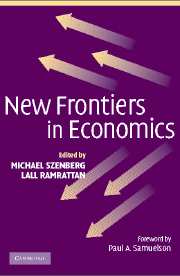Book contents
- Frontmatter
- Contents
- List of Contributors
- Foreword by Paul A. Samuelson
- Preface
- Acknowledgments
- Introduction
- PART I INFORMATIONAL BEHAVIORAL ECONOMICS AND FINANCE
- 1 Information and the Change in the Paradigm in Economics
- 2 Behavioral Economics
- 3 Experiments with Financial Markets: Implications for Asset Pricing Theory
- 4 Two Puzzles of Asset Pricing and Their Implications for Investors
- PART II MACROECONOMICS AND PUBLIC POLICIES
- PART III INTERNATIONAL TRADE AND DEVELOPMENT
- PART IV CONTRACTS, LAW, AND GAMING
- Author Index
- Subject Index
- References
4 - Two Puzzles of Asset Pricing and Their Implications for Investors
Published online by Cambridge University Press: 06 July 2010
- Frontmatter
- Contents
- List of Contributors
- Foreword by Paul A. Samuelson
- Preface
- Acknowledgments
- Introduction
- PART I INFORMATIONAL BEHAVIORAL ECONOMICS AND FINANCE
- 1 Information and the Change in the Paradigm in Economics
- 2 Behavioral Economics
- 3 Experiments with Financial Markets: Implications for Asset Pricing Theory
- 4 Two Puzzles of Asset Pricing and Their Implications for Investors
- PART II MACROECONOMICS AND PUBLIC POLICIES
- PART III INTERNATIONAL TRADE AND DEVELOPMENT
- PART IV CONTRACTS, LAW, AND GAMING
- Author Index
- Subject Index
- References
Summary
INTRODUCTION
The trade off of risk and return is becoming ever more important for individuals, institutions, and public policy. In fact, Bernstein (1996) suggests that the rational analysis of risk is a defining characteristic of the modern age.
This essay explores risk and return in aggregate stock market investment. It is based on several earlier expositional and research pieces, notably Campbell (1999, 2000, 2003), Campbell and Cochrane (1999), Campbell and Shiller (2001), and Campbell and Viceira (2002).
The comparison of the stock market with the money market is startling. For example, if we look at log real returns on U.S. stocks and Treasury bills over the period 1947.2–1998.4, we find, first, that the average stock return is 8.1 percent, while the average bill return is 0.9 percent; and second, that the volatility of the stock return is 15.6 percent, while the volatility of the ex post real bill return is only 1.8 percent.
These facts lead to two puzzles of asset pricing. The first was christened the equity premium puzzle by Mehra and Prescott (1985): Why is the average real stock return so high (in relation to the average short-term real interest rate)? The second might be called the equity volatility puzzle: Why is the volatility of stock returns so high (in relation to the volatility of the short-term real interest rate)? The classic reference to this second puzzle is Shiller (1981).
- Type
- Chapter
- Information
- New Frontiers in Economics , pp. 128 - 170Publisher: Cambridge University PressPrint publication year: 2004



